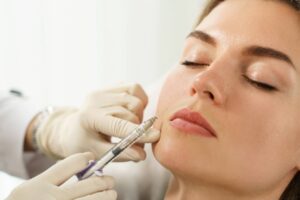What Is “Filler Burnout?”
 In recent years, injectable dermal fillers have become one of the most popular treatments for restoring facial volume and enhancing youthful contours. These quick, non-surgical procedures can produce beautiful results when used judiciously and by an experienced provider. With this in mind, as trends evolve and patient expectations shift, a new phenomenon has entered the aesthetic conversation: “filler burnout.”
In recent years, injectable dermal fillers have become one of the most popular treatments for restoring facial volume and enhancing youthful contours. These quick, non-surgical procedures can produce beautiful results when used judiciously and by an experienced provider. With this in mind, as trends evolve and patient expectations shift, a new phenomenon has entered the aesthetic conversation: “filler burnout.”
Also known as “filler fatigue,” filler burnout is increasingly used to describe the visual and emotional effects some patients experience after years of repeated dermal filler use.* Our Philadelphia plastic surgeon often consults with individuals who feel their fillers are no longer giving them the refreshed, natural appearance they once did (or worse, they feel their face looks puffy, distorted, or overdone). Fortunately, certain other treatments can provide a more lasting and elegant solution, as explained below.
What Causes “Filler Burnout?”
Filler burnout can manifest in several ways. Physically, it refers to the hollowing or laxity that can occur when patients stop using fillers after long-term treatment. Some believe fillers may stretch tissues or create an unnatural buildup of volume, particularly when injected excessively or into the wrong areas. Others may simply notice diminishing returns over time, requiring more and more frequent sessions to maintain the same level of improvement.
Psychologically, patients may begin to feel “off” about their appearance. What once felt rejuvenating may start to feel artificial. The convenience of touch-up appointments can evolve into a maintenance cycle that becomes expensive, time-consuming, and ultimately unsatisfying.
In Dr. DiBello’s view, the root of filler burnout often lies not with the fillers themselves, but in how they’re being used. When applied in moderation and with an artistic eye, fillers can yield excellent results; however, for those seeking comprehensive, long-term facial rejuvenation, facial fat transfer may be a better approach.
Why Facial Fat Transfer Can Offer a More Natural Solution
While every patient’s case is unique, Dr. DiBello generally advocates for facial fat grafting as an alternative to frequent filler use. This technique involves harvesting a small amount of fat from an area of the body (typically the abdomen, flanks, or thighs), purifying it, and carefully reinjecting it into areas of the face that have lost volume due to aging. The result is typically a softer, more natural-looking enhancement.
Unlike dermal fillers, which are eventually absorbed by the body and require repeated injections to maintain results, fat transfer uses your own living tissue. When performed by a skilled plastic surgeon like Dr. DiBello, a significant percentage of the transferred fat can establish a lasting blood supply and remain in place permanently. The results tend to look and feel more organic, as the restored volume should integrate seamlessly with the surrounding tissues.
Additionally, facial fat transfer offers the unique benefit of improving skin quality. Fat is rich in stem cells and growth factors that can enhance skin texture, tone, and elasticity over time.
A Thoughtful Approach to Facial Rejuvenation
While dermal fillers certainly have their place in aesthetic medicine, Dr. DiBello encourages those experiencing filler fatigue to consider the advantages of fat transfer. The procedure can address volume loss with fewer maintenance appointments and a more natural-looking result.
If you’re noticing signs of filler burnout or simply want to explore a more sustainable path to facial rejuvenation, Dr. DiBello would be happy to discuss whether facial fat transfer is right for you. As a board-certified, fellowship-trained plastic surgeon, he creates personalized treatment plans designed to enhance your appearance with subtlety, artistry, and longevity. Contact our office today to learn more.
